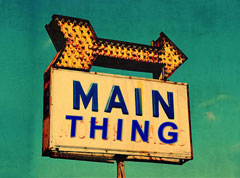 So far, in this series on major gift structure, we have established that:
So far, in this series on major gift structure, we have established that:
- Many organizations wrongly create structure around talent.
- There is a tendency to organize around similar activities or strategy.
- Often an authority figure “just decides” what the structure should be.
- At the macro, the development function should be organized into two fundraising functions: one directed towards individuals, the other towards institutions.
- The communications, marketing, PR and events functions should be separate from the fundraising functions with a major objective to mind the organizational brand.
- With all the above in place and guiding organization design, the entire fundraising effort should be viewed, first, from the donor’s point of view and her journey. Your effort should help her give to her capacity, to programs that match her interests and passions. We call this entire way of doing things the major gift pipeline.
I want to emphasize the two concepts that are critical features of the major gift pipeline:
- It has program categories and subcategories that a donor can “run” on – in other words, there are program giving tracks that match the passions and interests of the donor, and
- It has an economic focus and strategy that helps the donor give to their capacity. This is critical in that if you do the first one right, and there is a perfect match between the donor and your program, there will be very little resistance to that donor giving to their capacity, hence the name Major Gift Pipeline.
So, with all of the above in place which (admittedly) is not easy to do, there are four “main things” you must continually pay attention to:
- Product/Program/Offers – In our experience, this is a critical area in major gifts: having something to present to donors in exchange for their giving. As I mentioned in an earlier blog in this series, make sure you are transforming your entire budget into donor offers.
- Front line sales force – Another “main thing” is the talent. The front-line talent. Make sure they are competent, productive, well trained, experienced and loved and cared for.
- Support for the front line –Jeff and I have a lot of energy on this “main thing” – properly supporting the front line MGO with administrative support. I have written about the economic benefit of supporting the MGO with admin support. Take a look at this blog on that topic. You cannot hope to be successful in major gifts if you don’t support your MGO properly. (Tweet it!)
- Donor-facing back office – Last but not least, of the four main things is the back office, one of the most neglected areas in non-profits and certainly a major contributor to major gift program failure. I guess the reason the back office is often neglected is because it is “overhead” – that nasty, evil, money-sucking function that “we must keep under control” lest it grow into a monster. OK, let’s put that mentality to bed and start thinking about the donor. Thinking about the donor experience, ask yourself the following questions:
- What support services do we need, to make sure we are caring for our donors and constantly telling them that their giving is making a difference?
- Do all of our receipting and donor care staff really care about the donor? If they don’t, what are we going to do about it?
- Do we have the proper analysis systems and staff to help us understand how we are doing in retaining, upgrading and fulfilling donor interests and passions?
- Are all of our programs effective, and do they fulfill our organization’s mission? Can we prove they are?
- Are we getting results and outcome information for every program a donor supports, so we can pass it on to them?
- Are we getting stories that take the donor to the front line – that are emotional and motivating – that grab their hearts and move them with compassion and caring?
- Do our data processing and financial systems take care of donor needs as well as financial, organizational and program needs?
- Do we have ongoing donor research that keeps us in touch with the hearts of our donors?
There may be more questions to ask, but here is my point: if you truly re-orient everything about your fundraising to be donor-facing, and you adopt the major gift pipeline concept Jeff and I are proposing, it will change how you operate. That’s because it will all be about serving the donor and her interests and passions, rather than just about getting her money.
That reset will result in higher donor and value retention – and more net revenue for your important mission.
Richard
Read the whole series on MG Organizational Structure:
- What’s Wrong
- The Right Context
- The Major Gift Pipeline
- The Four Main Things (this post)
- Can’t We All Get Along
- Reengineer to be Donor-Facing







0 Comments
Trackbacks/Pingbacks